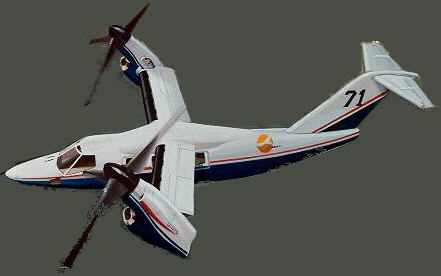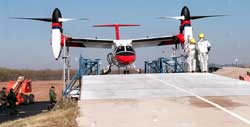Monday
December 23, 2002
BA609 Tests Set Stage For First Hover Flight
ARLINGTON, Texas, USA ( EDWARD H. PHILLIPS for Aviation Week Magazine ) -
The world's first commercial tiltrotor initiative is moving forward with FAA certification planned for January 2007
Bell/Agusta Aerospace Co.'s BA609 has begun six weeks of crucial systems tests that company officials expect will lead to first flight of the aircraft early
next year.
Bell Helicopter Textron Chairman/ CEO John Murphey said the BA609 trials
represent a "new benchmark in aviation history." In his view, the aircraft
"will revolutionize air transportation." Both engines of the first
preproduction BA609 were started on Dec. 6 at Bell's Flight Research Center
here, where a majority of the aircraft's test program will be conducted.
About 50 hr. of testing is scheduled for completion before the aircraft can be
approved to make its first hover flight. Company officials are confident,
however, that the BA609 will fly in either late January or early February,
barring any major technical problems with hardware or software.
 DURING THE PAST YEAR, progress on the program had been slowed dramatically
because of two fatal crashes in 2000 involving the Bell Boeing V-22 military
tiltrotor. That aircraft, however, has resumed flying at NAS Patuxent River,
Md., and is advancing slowly through an exhaustive flight test program ( AW&ST
Dec. 2, p. 33). As BAAC officials are quick to point out, the BA609 is a
different aircraft than the V-22 and is designed to commercial, not military,
regulations and requirements and will be subject to a different set of
certification standards. How rapidly the BA609 program progresses, however, is
tied to continued success of the MV-22 for the U.S. Marine Corps.
"Overall, the outcome was very positive, and we look forward to further testing
of the BA609," said Jack Gallagher, director of the BA609 program for Bell/
Agusta Aerospace Co. For the initial runs, the BA609 was secured on a rotor
test stand platform previously used to test dynamic rotor components for the
Bell Boeing V-22 military tiltrotor during the late 1990s.
The platform allows the aircraft to be tied down for testing while still
permitting full transition of the nacelles between helicopter and airplanes
modes. The transition takes about 20 sec. in either direction, according to
Gallagher. Conversion is accomplished through dual ball screws on each actuator
and dual hydraulic drives for each nacelle that include clutch and brake
arrangements. Three computers control the actuators, and both electrical and
hydraulic power installations feature triple redundancy and are separate
systems. Three coincident failures would be required to stop an actuator,
according to John Magee, lead engineer for the BA609.
DURING THE PAST YEAR, progress on the program had been slowed dramatically
because of two fatal crashes in 2000 involving the Bell Boeing V-22 military
tiltrotor. That aircraft, however, has resumed flying at NAS Patuxent River,
Md., and is advancing slowly through an exhaustive flight test program ( AW&ST
Dec. 2, p. 33). As BAAC officials are quick to point out, the BA609 is a
different aircraft than the V-22 and is designed to commercial, not military,
regulations and requirements and will be subject to a different set of
certification standards. How rapidly the BA609 program progresses, however, is
tied to continued success of the MV-22 for the U.S. Marine Corps.
"Overall, the outcome was very positive, and we look forward to further testing
of the BA609," said Jack Gallagher, director of the BA609 program for Bell/
Agusta Aerospace Co. For the initial runs, the BA609 was secured on a rotor
test stand platform previously used to test dynamic rotor components for the
Bell Boeing V-22 military tiltrotor during the late 1990s.
The platform allows the aircraft to be tied down for testing while still
permitting full transition of the nacelles between helicopter and airplanes
modes. The transition takes about 20 sec. in either direction, according to
Gallagher. Conversion is accomplished through dual ball screws on each actuator
and dual hydraulic drives for each nacelle that include clutch and brake
arrangements. Three computers control the actuators, and both electrical and
hydraulic power installations feature triple redundancy and are separate
systems. Three coincident failures would be required to stop an actuator,
according to John Magee, lead engineer for the BA609.

|
"The initial ground runs gave us the opportunity to check many of the
parameters of the systems, and we found that some of them needed adjustment,"
Gallagher said. "We received a few caution advisories on the systems, but
nothing we did not expect." In addition, hydraulic and fuel systems were
inspected for leaks. Bell test pilots Roy Hopkins and Dwayne Williams were at
the controls of the aircraft during the ground runs and are scheduled to fly
the BA609 on its first flight, Gallagher said.
Before the engines were started, Hopkins ran a series of "dry runs" using the
starter only and without introducing fuel to the Pratt & Whitney Canada
PT6C-67A turboshaft powerplants. After these checks were completed and
adjustments made to fuel system components, both engines were started and run
at flight idle (50% gas generator rpm.) to investigate rotor balance, according
to Gallagher.
"We're going to do a lot of proprotor parameter checks early in the testing,"
including evaluations of the proprotors during transition between helicopter
and airplane modes, he said.
Pratt & Whitney Canada already has completed more than 1,000 hr. of engine runs
at its facilities near Montreal, according to Gallagher. Production engines
will be slightly different from those in the preproduction BA609, and will each
be rated at 1,940 shp. (sea level, standard day). The same engines will be used
in production Agusta/Bell AB139 helicopters developed by BAAC. The AB139 is
currently undergoing flight tests in Italy and is scheduled for Italian
certification in the second quarter of 2003.
Another key element of the first round of BA609 testing was ensuring proper
operation of the aircraft's data telemetry systems, which will be used
throughout the flight test program. Following the initial tests on Dec. 6, a
team of engineers and mechanics worked on the aircraft during the weekend,
making a series of corrective actions to systems components. Although plans
called for testing on Dec. 7 and Dec. 8, inclement weather delayed the
resumption of engine runs until Dec. 10.
"WE ARE IN THE PROCESS of putting together a detailed plan for assembly of
ships 2, 3 and 4, and expect to finish that planning by the end of
first-quarter 2003," Gallagher said. Bell is in negotiations with
AgustaWestland to determine the exact schedule for assembly of the three
airframes as well as how costs will be distributed between the two companies.
Gallagher anticipates a 36-month flight test program to certify the BA609. The
first aircraft will be used chiefly to expand the flight envelope. The second,
third and fourth aircraft will be dedicated to systems certification, avionics
and icing approvals, and FAA Function and Reliability flights.
Static and fatigue tests of the primary airframe structure are scheduled to
begin in the first quarter of 2003 and continue for one year, according to
Gallagher. BAAC engineers expect to perform fatigue tests and analyses
equivalent to more than 40,000 hr. of service for the airframe--twice the
aircraft's intended life of 20,000 flight hours, according to Donald J.
Barbour, executive director of BAAC's civil tiltrotor program. Testing of all
safety-of-flight major components has been completed, he said.
Barbour said the BA609 will be certified to FAA Part 29 and Part 35, and will
meet stringent Category A performance standards for takeoff under one-engine
inoperative conditions. At its maximum takeoff weight of 16,800 lb., the
aircraft would be capable of lifting to a hover at sea level, ISA +20C. If an
engine failed, the pilot would have the option of continuing the departure and
climbing, or landing back on the helipad. Bell reports having more than 85
orders for the BA609 from 40 customers in 18 countries.
If the program continues and a decision to produce the aircraft is made, final
assembly, testing and customer delivery in the U.S. would occur at Bell's
facilities in Amarillo, Tex. A separate assembly and delivery pipeline for
European customers would be established at Agusta's facilities in Italy,
according to BAAC Managing Director, Jim Rogers. Production fuselages would be
built by Fuji Heavy Industries in Japan, and all parts and components for both
assembly lines would be procured from the same source, "yielding aircraft that
will be identical, whether assembled in Texas or Italy," according to Bell.
BAAC headquarters is located at the Alliance Airport north of Fort Worth. A
customer training center is planned at the Alliance base, and would include
classrooms and simulators for both pilots and mechanics. A supplier for the
full-flight simulators has not been chosen, nor have FAA and BAAC officials
agreed on all aspects of the training curriculum for pilots.
The BA609 is projected to have a cruise speed of 275 kt. at 25,000 ft., and
would be equipped with an anti-icing system on the proprotors and a deicing
system on the wings. The cabin, which is designed to accommodate up to nine
passengers, would be pressurized to a maximum differential of 5.5 psi.
Gallagher said the preproduction aircraft is equipped with a fly-by-wire flight
control system, and BAAC will seek FAA approval for dual- and single-pilot
operation under instrument flight rules. Range with standard tanks is estimated
to be 750 naut. mi. (no reserve), or 1,000 naut. mi. with optional auxiliary
fuel tanks. Useful load is projected to be 5,500 lb. Base price for a typically
equipped aircraft has not been determined.
In addition to use by business aviation operators, Barbour foresees the BA609
as an alternative to fixed-wing aircraft and helicopters flown by charter and
air taxi companies, law enforcement agencies and offshore oil transport
operators.
News: World's first commercial Tiltrotor training academy
News: Wing mated to Bell/Agusta Tiltrotor BA609
News: Bell enters 21st Century with new orders
News: Osprey 's big cousin excites Pentagon
News: BA609 Tiltrotor announced
BA609 page
Bell timeline
Agusta timeline
XV-15 Tilt rotor


